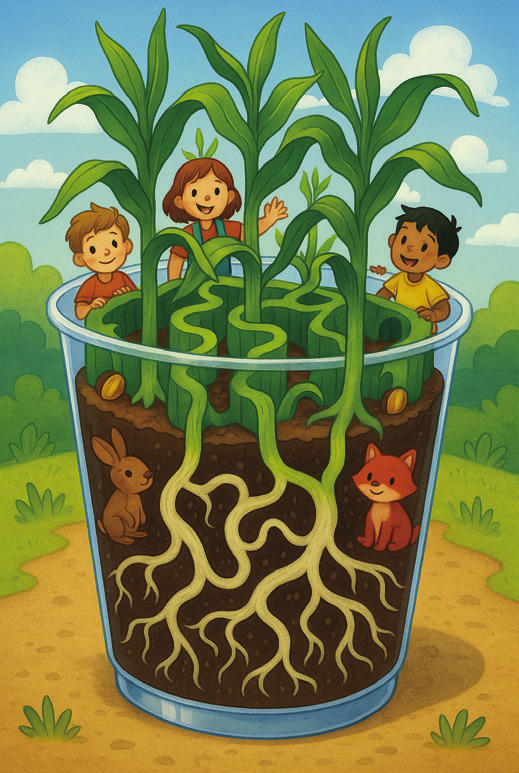This week’s entry in our Summer Science Project series brings together farming, curiosity, and a dash of gravity. If you’ve got a curious kiddo (or just love watching plants do weird things), this one’s for you. It’s low-cost, hands-on, and packed with agricultural science. And yes—it involves corn.
PROJECT OVERVIEW: THE CORN MAZE IN A CUP Kids will plant corn seeds in clear cups lined with damp paper towels to observe how the roots and shoots grow. But halfway through, we’ll shake things up—literally—by turning the cup on its side or upside down to see how the plant responds. This project demonstrates gravitropism—the way plants sense and respond to gravity. It’s fun, fast, and totally farm-worthy.
What You’ll Need (per kid): 1 clear plastic cup (Solo- style or recycled) 2 paper towels 2 corn kernels (field corn or popcorn) Water Scotch tape 1 sandwich bag (optional, helps trap moisture) Black construction paper or duct tape (optional: for wrapping to simulate underground) Steps: 1. Fold and roll a paper towel so it lines the inside wall of your clear cup.
2. Wet the towel slightly until it’s damp, not soaked.
3. Place a corn seed between the towel and the side of the cup where it can be easily seen.
4. Set the cup upright in a warm place near sunlight or a grow light.
5. Watch as the seed begins to sprout over the next 3–5 days.
6. Once the root and shoot are visible, rotate the cup sideways or upside down.
7. Keep observing—within a few days, the shoot will turn and grow upward again, and the root will bend downward.
What’s Going On? This is a great way to explore gravitropism—the way plants detect and grow in response to gravity. Even if you flip a seed upside down, it knows which way to send the roots (down) and the shoots (up). That’s part of what makes farming so successful: nature’s built-in GPS.
Bonus Ideas: Use several cups with different variables—one in sunlight, one in darkness, one rotated every day.
Try using other types of seeds: beans, peas, or even sunflower seeds.
Start a “corn cup race” with siblings or classmates to see whose seed sprouts first.
Estimated Cost: Under $1 per kid—most items are common household materials. Corn seeds are inexpensive and often sold in bulk.
Side Note for Experimenters: If you have extra cups and seeds, challenge kids to try different setups. What happens if you use beans or peas instead of corn? What if you keep one cup in the dark and another in the sun? What if you rotate the cup every single day? You might just discover a new farming trick—or at least have a great time experimenting.
Whether you’re on a farm or just curious about how things grow, this science project is a great way to connect kids to the soil, the seasons, and the strange and amazing ways life finds its way upward.
Stay tuned for next week’s project and keep those questions growing!



